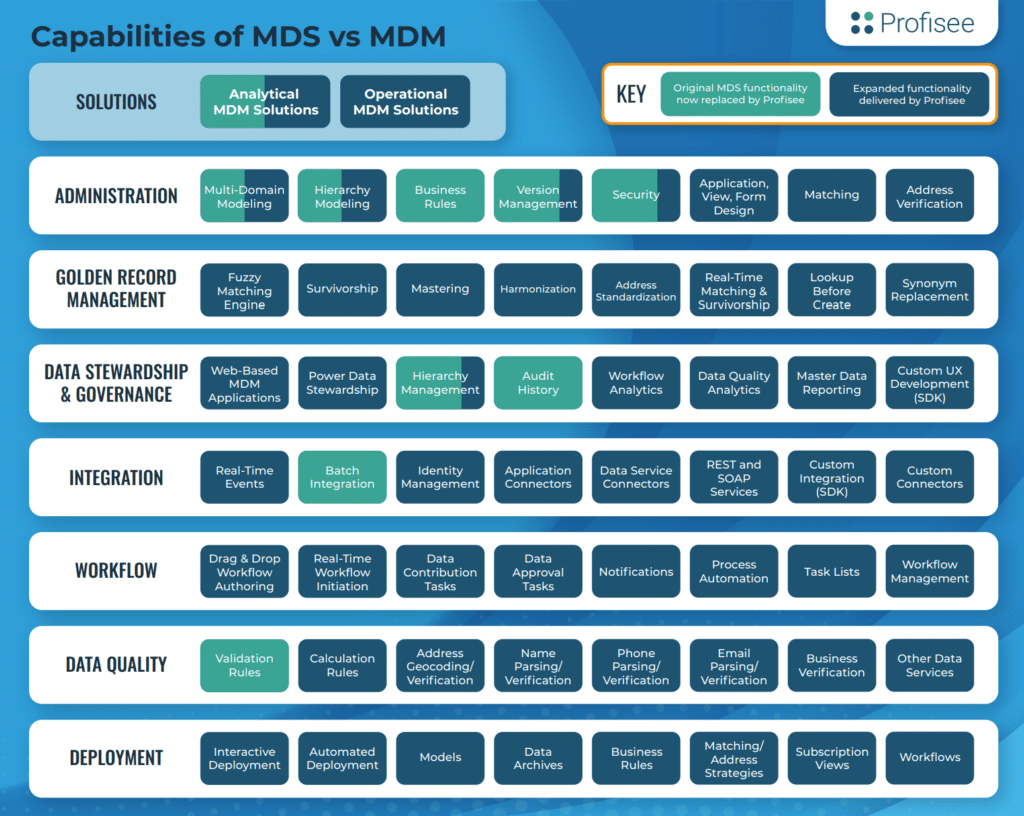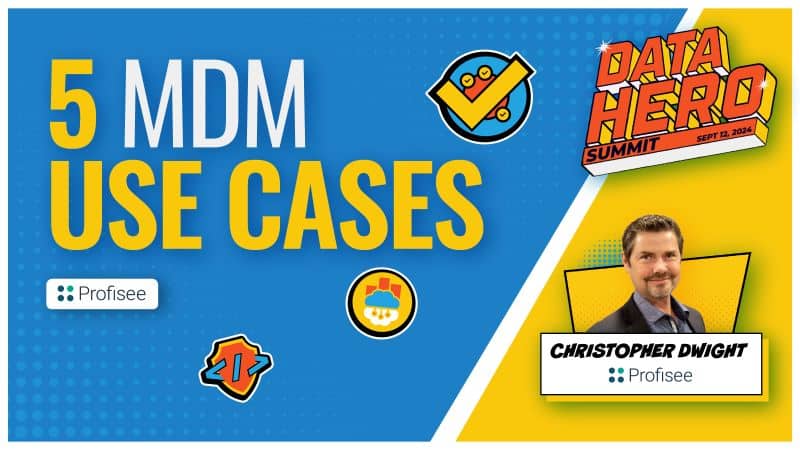Table of Contents
Microsoft Master Data Services (MDS) has been bundled within SQL Server software (2008 R2) since 2010 — and based on my experience at Gartner — is being used widely across a wide array of companies and industries.
MDS enables companies to leverage an SQL Server database as a single source of truth within their organizations — with some basic master data persistence, synchronization, quality and data syndication capabilities.
While not a complete enterprise-class master data management (MDM) solution like Profisee and others in Gartner’s MDM Magic Quadrant, MDS can be a sufficient solution for reference data and a very limited number of other master data use cases. So, while the capabilities of MDS significantly pale in comparison to best-of-breed MDM solutions, having some decent data management capabilities without means MDS has been widely implemented — and used.
The MDS Dilemma: Low-cost but Limited Functionality
However, as vendors of best-of-breed MDM solutions have aggressively invested in adding features and functions to their solutions over recent years, the integration of new features into MDS has lagged. The slow pace of major product improvements to MDS — in conjunction with many companies outgrowing the limitations of MDS for enterprise-class MDM — leads many data leaders to question if MDS is the right fit for their organizations.
This tension between a free product — which increasingly fails to meet rapidly evolving MDM needs — generated a low and persistent volume of questions about MDS while I was a Gartner analyst. Every week, I could count on at least one of two CIOs or CDOs asking me ‘Is MDS going away?’ or ‘Should I consider an alternative to MDS for MDM?’
The answer I would give my clients was consistent:
“MDS has some decent features for a limited number of MDM use cases, but if you requirements call for enterprise-class MDM capabilities — which they likely do — then you should probably consider alternatives.”
Typically, the biggest concerns expressed to me by users of MDS were around missing functionality for complex hierarchy management, data quality — including complex entity resolution/matching — and data governance. Data leaders would also express significant concerns around a general lack of visibility on the MDS roadmap and confusion about Microsoft’s commitment to MDS as a product.
Microsoft’s Support Plan for Master Data Services
Some of the concerns on the last issue — of if Microsoft will continue to support MDM — were partially addressed recently with the release of SQL Server 2022 — which included a refreshed version of MDS.
However, it still significantly lags the broader MDM software market in terms of features and functions, and looming questions about the overall commitment of Microsoft to this product remain — especially considering major commitments by Microsoft to other data management solutions, like the G
What this all means is that MDS will continue to be a cause for stress among data leaders who are struggling to understand if they should continue using MDS, or if they should look at other MDM solutions.
And this stress is completely valid — given that many companies are actively using MDS to support operational MDM use cases — including reference data. This means that any effort to replace MDS could be highly disruptive to downstream business processes that are reliant on MDS as a source of master data.
Worse yet, it’s often the case that MDS was implemented years ago, and many of the people who may have supported its deployment — either from the business application or IT side — are no longer with the company. In these scenarios, for many data leaders, the risk of possible business disruption weighs heavily on the decision to reluctantly stick with the MDS status quo — as suboptimal as it may be.
Master Data Services in 2023: Where Do We Go from Here?
It’s a foregone conclusion that best-of-breed MDM software providers, like Profisee, will continue to invest in their platforms. And given the history of MDS, it’s very likely that the lack of functional parity between MDS and MDM software solutions will only worsen.
And with every day that passes, organizations without an enterprise-class MDM solution will increasingly lag behind their peers who are leveraging MDM for competitive market advantage. As I noted in the last MDM Magic Quadrant, master data management has transitioned from a “nice-to-have” to a “must-have”, and any company serious about digital transformation needs to operate from a solid foundation of master data.
What this means is that data leaders dependent on MDS will very shortly be faced with a difficult decision: What is the best way to migrate to a better, more robust MDM solution that aligns with our long-term data strategy without completely breaking every legacy process dependent on MDS?
DATA INSIGHTS,
DIRECT TO YOUR INBOX
Modern Data Management to Support Digital Transformation
What I recommend is that data leaders dependent on MDS start looking for alternative solutions sooner rather than later or run the risk that in the next release of SQL Server MDS is no longer supported — or worse yet — sunset altogether. In my experience being on the offense as opposed to the defense, it will at least give you time and options that taking a defensive posture likely will not provide.
Yes, this means data leaders will need to pay for an MDM solution where they’re essentially getting one for “free” now. However, in my conversations with companies around the globe in this situation — every single one of them had significant challenges that could easily justify the investment needed for a new MDM platform. It was never the lack of a business need that stopped CIOs from considering a replacement of MDS, it was the fear associated with what could go wrong when they tried to replace it.
Not only does moving from MDS to a new MDM provide better capabilities, but it likely better aligns with your overall IT strategy. The reality of the rapidly-evolving modern data ecosystem is that complex data management capabilities, like MDM and data governance, aren’t being coded into the database management systems — they’re being deployed as freestanding applications that are deeply integrated into cloud data ecosystems, like Azure and Amazone Web Services (AWS).
Clearly, there are benefits to having some data management capabilities within the databases used by business applications — but more advanced data management capabilities are being deployed independently of DBMSs. This makes complete sense given the average large company will be running numerous databases, but increasingly all those databases are being deployed in a very limited number of cloud environments — and often only just one.
To help data leaders overcome the fears associated with ripping out MDS, I recommend they plan on running MDS in parallel with a new MDM solution. The new MDM solution will likely be far better suited to support more complex and customer-facing use cases in the digital realm, where it’s likely companies will be able to easily identify net-new MDM use cases that don’t require both the new solution and MDS to be utilized.
Over time — so long as Microsoft is supporting MDS — companies can plan on slowly migrating MDM processes off MDS and onto the new MDM platform. There will be costs incurred by having two systems where there was previously one, but the business case/ROI of the new MDM platform will likely be easily justified given the functional deficit most companies have been experiencing for the years they’ve forgone investment in a more robust MDM solution.

Align Your Data Strategy with Your Business Needs (Even if That is MDS for Now)
MDS has been a decent, low-cost solution to help companies support a limited number of MDM use cases for well over a decade.
For some companies early in their MDM journeys, MDS may continue to be a viable solution for MDM in the short term. However, the MDM requirements of most companies that could justify using MDS over the last 10 years, today significantly exceed the capabilities of MDS. Given MDM has transitioned to a must-have capability to support the digital aspirations of companies, data leaders dependent on MDS should seek to implement best-of-breed MDM solutions that better align with both their long-term business and IT strategies.
For most companies, taking a “wait and see” approach to the capabilities offered by enterprise-class MDM solutions in favor of the continued use of MDS represents a material risk in their ability to meet evolving business needs.
Malcolm Hawker
Head of Data Strategy @ Profisee

Malcolm Hawker
Malcolm Hawker is a former Gartner analyst and the Chief Data Officer at Profisee. Follow him on LinkedIn.












